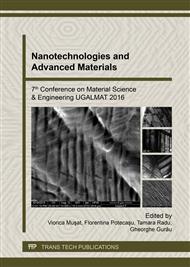[1]
P.K. Rohatgi, S. Ray and Y. Liu, Tribological properties of metal matrix-graphite particle composites, in International Materials Reviews, vol. 37, no. 3, 1992, pp.129-149.
DOI: 10.1179/imr.1992.37.1.129
Google Scholar
[2]
S.V. Tesh. Sharikumar, V. kannankjajapal, Studies on Aluminium-graphite by Stir Casting Technique, international journal of scientific and engineering research, volume 4, Issue 9, September -2013, ISSN, pp.2229-5518.
Google Scholar
[3]
N. Barekar, S. Tzamtzis, B. K. Dhndaw, J. Patel, N. Haribabu and Z. Fan, Processing of Aluminium-Graphite particulate metal matrix composites by advanced shear technology, journal of materials engineering and performance, ASM International (2009).
DOI: 10.1007/s11665-009-9362-5
Google Scholar
[4]
B.J. Keene, Review of data of surface tension of pure metals, Intern. Mat. Rev. 38/4, 1993, pp.157-192.
Google Scholar
[5]
P. Shen, H. Fujii, T. Matsumoto, K. Nogi, Influence of substrate crystallographic orientation on the wettability and adhesion of a-Al2O3 single crystals by liquid Al and Cu, J. Mat. Sc. 40, 2005, pp.2329-2333.
DOI: 10.1007/s10853-005-1954-3
Google Scholar
[6]
E.A. Pastukhov, V.P. Chentsov, A.V. Kiselev, L.E. Bodrova, A.V. Dolmatov, E.A. Popova, S.A. Petrova, R.G. Zacharov, wetting of graphite surface by the aluminiumalloys melts, Institute of Metallurgy UB RAS Ekaterinburg.
Google Scholar
[7]
K. Keehyun, Formation of fine clusters in high – temperature oxidation of molten aluminium, Metall. and Mat. Trans. A 45A, 2014, pp.3650-3660.
Google Scholar
[8]
N. P. Hung, M. Velamati, E. Aguilar, M. A. Garza-Castañon, and M. Powers, joining of advanced aluminium-graphite composite, materials fabrication, properties, characterization and modeling TMS (the minerals, metals and materials s0ciety), (2011).
DOI: 10.1002/9781118062142.ch97
Google Scholar
[9]
P. Baumli, J. Sytchev, G. Kaptay, Perfect wettability of carbon by liquid aluminum achieved by a multifunctional flux, J Mater Sci, 2010, 45: 5, p.177–5190.
DOI: 10.1007/s10853-010-4555-8
Google Scholar
[10]
N. Eustathopoulos, J. C. Joud, P. Desre, the wetting of carbon by aluminium and aluminium alloys, journal of materials science 9, 1974, pp.1233-1242.
DOI: 10.1007/bf00551836
Google Scholar
[11]
M. YAN, Z. FAN, Review Durability of materials in molten aluminum alloys, Journal of materials science 36, 2001, pp.285-295.
Google Scholar
[12]
K. L. Juhasz, P. Baumli, G. Kaptay, Fabrication of carbon fibre reinforced, aluminium matrix composite by potassium iodide (KI) – potassium hexafluorotitanate (K2TiF6) flux, Mat. -wiss. u. Werkstofftech. 2012, 43, No. 4.
DOI: 10.1002/mawe.201200946
Google Scholar
[13]
G. Neagu, F. Stefanescu, metallic matrix composites with particles, Editura BREN, Bucuresti, (2002).
Google Scholar
[14]
V. Laurent, D. Chtan, N. Eustathopoulos, Wettability of SiC by aluminum and Al-Si alloys, J. of Mat. Sci., Vol 22, 1987, pp.244-250.
DOI: 10.1007/bf01160579
Google Scholar
[15]
N. SOBCZAK, improvement of wetting and bonding of dissimilar materials, high technology, Interfacial science in ceramic joining, volume 58, 1998, Kluwer Academic publishers. Printed in the Netherlands, pp.27-42.
DOI: 10.1007/978-94-017-1917-9_3
Google Scholar
[16]
I. A. Ibrahim, F. A. Mohamed, E. J. Lavernia, Particulate reinforced metal matrix composites - a review, Journal of materials science, 26, 1991, pp.1137-1156.
DOI: 10.1007/bf00544448
Google Scholar
[17]
Zhengang Liuy, Guoyin Zu, Hongjie Luo, Yihan Liu and Guangchun Yao, Infuence of Mg Addition on Graphite Particle Distribution in the Al Alloy Matrix Composites, J. Mater. Sci. Technol., 2010, 26(3), pp.244-250.
DOI: 10.1016/s1005-0302(10)60041-2
Google Scholar
[18]
S. SEAL, T. Warwick, A. Garcia, H. Ade, J. Denlinger, B. Tonner, T. L. Barr, N. Sobczak, Soft X-ray spectromicroscopy in application to problems in material science, Proc. Int. Conf. high temperature capiliarity 29 June – 2 July 1997, Cracow, Poland Edited by N. Eustathopoulos and N. Sobczak.
Google Scholar
[19]
M. Di Sabatino, L. Arnberg, A review on the fluidity of Al based alloys, Metallurgical Science and Technology Norwegian, A. Getz vei 2B, N-7491 Trondheim (Norway), pp.9-15.
Google Scholar
[20]
B. C. Pal, Production of cast aluminium-graphite particle composites using a pellet method, journal of materials science, 13, 1978, pp.329-335.
DOI: 10.1007/bf00647777
Google Scholar
[21]
M Ananth Kumar, R. Chandra Agarwala and V. Agarwala, Synthesis and characterization of electroless Ni–P coated graphite particles, Bull. Mater. Sci., Vol. 31, No. 5, October 2008, p.819–824. © Indian Academy of Sciences.
DOI: 10.1007/s12034-008-0130-1
Google Scholar
[22]
B. P. Krishnan, M. K. Surappa, P. K. RohatgiI, The UPAL process: a direct method of preparing cast aluminium alloy-graphite particle composites, journal of materials science, 16, 1 981, pp.1209-216.
DOI: 10.1007/bf01033834
Google Scholar
[25]
N. Eustathopoulos, B. Drevet, M. L. Muolo, The oxygen-wetting transition in metal/oxide systems,. Mater. Sci. Eng. A 2001, 300, p.34–40.
DOI: 10.1016/s0921-5093(00)01790-1
Google Scholar
[23]
S. Bao, A. Kvithyld, S. Gaal, T. A. Engh, M. Tangstad, wetting of pure aluminium on filtermaterials graphite, AlF3 and Al2O3, TMS (The minerals&materials society), (2009).
DOI: 10.1016/s1003-6326(11)61410-6
Google Scholar
[24]
N. Eustathopoulos, N. Sobczak, A. Passerone, K. Nogi, Measurement of contact angle and work of adhesion at high temperature, journal of material sience 40, 2005, p.2271 – 2280.
DOI: 10.1007/s10853-005-1945-4
Google Scholar


